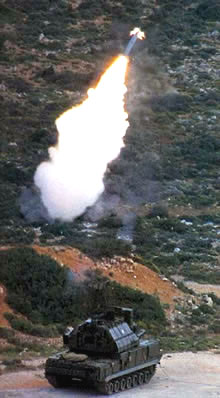WASHINGTON -- Iran has received more than $1 billion in air defense systems in the last two years according to a government report.

The Tor-M1 is a fully integrated combat vehicle with anti-missile and anti-aircraft missiles. The Congressional Research Service said Russia has shipped 30 air defense systems to Iran since January 2007. In a report, CRS identified the system as the TOR-M1 mobile, short-range surface-to-air missile.
"In September 2006, Ukraine agreed to sell Iran the Kolchuga radar system that can improve Iran's detection of combat aircraft," CRS said.
In December 2007, the report said, Russia agreed to sell the long-range S-300 air defense system. The report said the S-300, also known as SA-20, would greatly enhance Iran's air defense capability.
"The value of the deal is estimated at $800 million," the report said.
CRS said Iran has signed a contract for the S-300, which was to have been delivered by March 2009 and deemed operational three months later. But a month before scheduled delivery, the Russian media asserted that the Kremlin had delayed export to Iran because of "political considerations."
"Delivery has not taken place to date, by all accounts, and Israel said in August 2009 that Russia had agreed not to deliver any equipment to Iran that would upset the regional balance of power," the report said.
The report said Iran has sought integrate its Russian systems with U.S.-origin air defense assets. CRS cited the I-Hawk and Stinger surface-to-air missiles.
Obama opts for engagement over Iran opposition as unrest grows
Iran's government continues to face problems with controlling the population following the riots that broke out earlier this year over the disputed election that returned Mahmoud Ahmadinejad to the post of president, according to Iranian dissident sources.
There is widespread dissatisfaction with the clerical regime in Tehran and opposition to the Islamist regime is continuing to grow.

The unrest that rocked Iran in June [ZOOM] is still not under control today. democraticunderground.com The opposition extends beyond the business and cultural elites and includes nascent opposition forces within the military, the intelligence services and even the Islamist shock troops that are the main power in Iran, the Islamic Revolutionary Guards Corps, according to the sources who were recently been inside the country.
Despite the growing opposition, the Obama administration recently cut off support for anti-regime opponents as part of its new initiative to seek a diplomatic solution to Iran's refusal to halt its illicit uranium enrichment program.
The cutoff of U.S. support for several opposition groups was one of Tehran's conditions for engaging the Obama administration.
GERTZ:Russia has delivered 30 air defense systems to Iran since 2007
- Russia Halts Defense Missiles To Iran
Debka: Russia halts TOR-M1, S-300 air, missile defense missiles to Iran DEBKAfile Exclusive Report October 11, 2009, 9:07 PM (GMT+02:00) DEBKAfile's military sources report that Russia's abrupt suspension of consignments of advanced Tor-M1 air...
- Iran Negotiating With Belarus For Strategic Air Defense System ...
GERTZ: LONDON -- Western intelligence sources said Belarus has been negotiating the sale of a strategic air defense system to Iran. The sources the two countries have been discussing Iranian procurement of surplus Soviet-origin S-300 air...
- Reported Before, Confirmed. Russian Pantsyr For Syria, Ordered By Iran
Previously mentioned Denied, semi admitted, now DELIVERED GERTZ -MOSCOW — Russia is delivering an advanced surface-to-air missile system to Syria. Officials said the state-owned arms export agency, Rosoboronexport, has been exporting the Pantsyr-S1E...
- Russia Accelerates Deliveries Of Anti Aircraft Missiles To Iran And Syria...recall The Ambassador, George
MOSCOW — Russia has delivered more than half of the anti-aircraft defense systems ordered by Iran and Syria. Russian defense officials said Moscow has accelerated deliveries of surface-to-air missiles to Damascus and Teheran over the past few months....
- We Are On Our Own Except For A Very Few, And Perhaps That's The Way It Will Be
Ukraine sells Iran strategic radar systems designed to detect U.S. stealth aircraft MOSCOW — Iran has ordered and acquired several advanced anti-aircraft systems from the Ukraine. Russian industry sources said the Ukraine has sold an undetermined...
